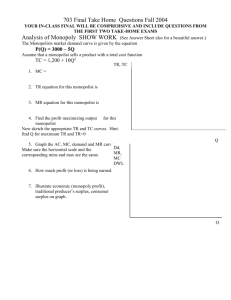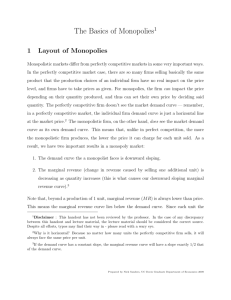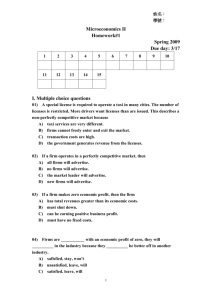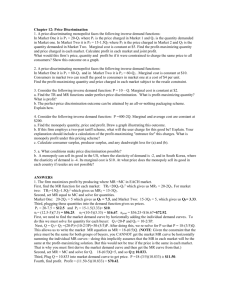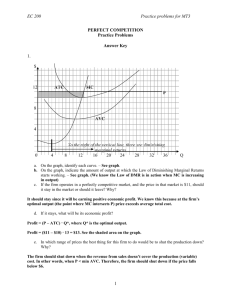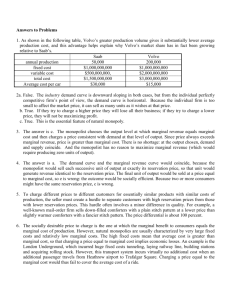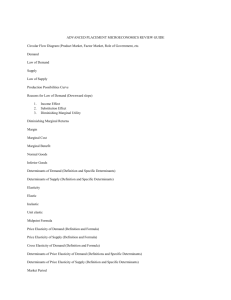1 Chapter 9 Problems
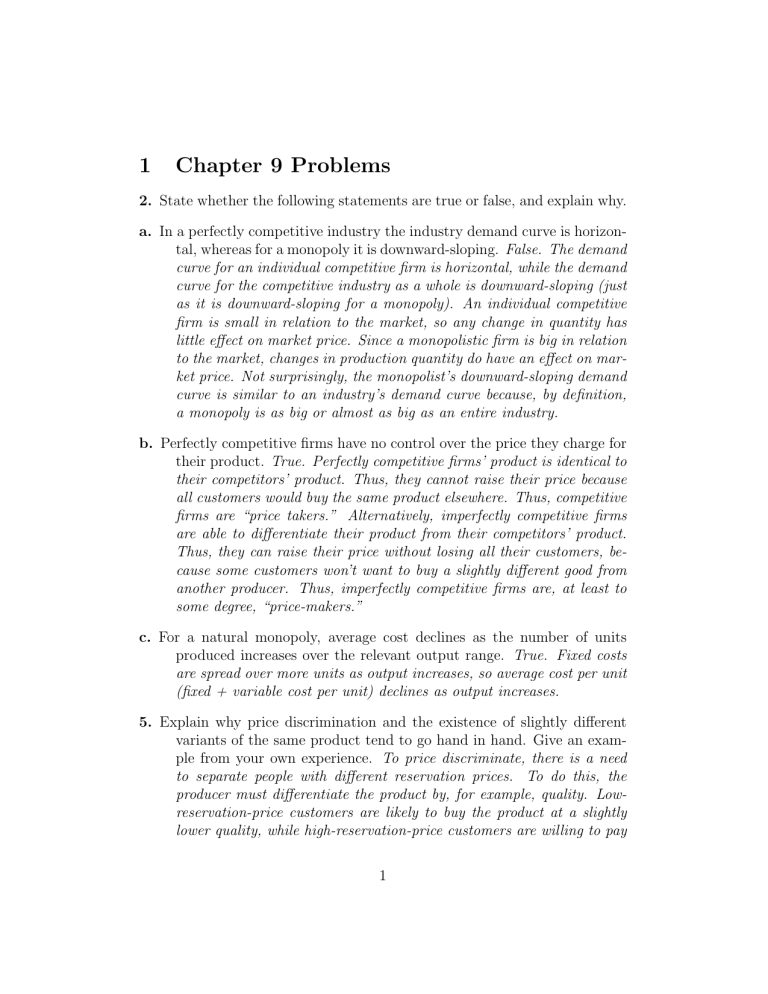
1 Chapter 9 Problems
2.
State whether the following statements are true or false, and explain why.
a.
In a perfectly competitive industry the industry demand curve is horizontal, whereas for a monopoly it is downward-sloping.
False. The demand curve for an individual competitive firm is horizontal, while the demand curve for the competitive industry as a whole is downward-sloping (just as it is downward-sloping for a monopoly). An individual competitive firm is small in relation to the market, so any change in quantity has little effect on market price. Since a monopolistic firm is big in relation to the market, changes in production quantity do have an effect on market price. Not surprisingly, the monopolist’s downward-sloping demand curve is similar to an industry’s demand curve because, by definition, a monopoly is as big or almost as big as an entire industry.
b.
Perfectly competitive firms have no control over the price they charge for their product.
True. Perfectly competitive firms’ product is identical to their competitors’ product. Thus, they cannot raise their price because all customers would buy the same product elsewhere. Thus, competitive firms are “price takers.” Alternatively, imperfectly competitive firms are able to differentiate their product from their competitors’ product.
Thus, they can raise their price without losing all their customers, because some customers won’t want to buy a slightly different good from another producer. Thus, imperfectly competitive firms are, at least to some degree, “price-makers.” c.
For a natural monopoly, average cost declines as the number of units produced increases over the relevant output range.
True. Fixed costs are spread over more units as output increases, so average cost per unit
(fixed + variable cost per unit) declines as output increases.
5.
Explain why price discrimination and the existence of slightly different variants of the same product tend to go hand in hand. Give an example from your own experience.
To price discriminate, there is a need to separate people with different reservation prices. To do this, the producer must differentiate the product by, for example, quality. Lowreservation-price customers are likely to buy the product at a slightly lower quality, while high-reservation-price customers are willing to pay
1
higher prices - but only for the higher quality version. Name-brand clothing designers price-discriminate by quality: they sell full-priced items in boutiques, while “irregular” units are sold at discount prices during sales or at discount stores.
6.
What is the socially desirable price for a natural monopoly to charge?
Why will a natural monopoly that attempts to charge the socially desirable price invariably suffer an economic loss?
The socially desirable price equals the marginal cost of the product. This price is found at the intersection of the demand and marginal cost curves (D = MC). But to price at marginal cost, the monopolist only covers variable cost and does not account for any fixed costs that may exist. Instead of setting price to marginal cost, a monopolist must set price to average total cost in order to avoid making a loss. In other words, since ATC = MC +
F/Q, setting P to MC makes P less than ATC, so the firm makes a loss.
7.
TotsPoses Inc., a profit-maximizing business, is the only photography business in town that specializes in portraits of small children. George, who owns and runs TotsPoses, expects to encounter an average of eight customers per day, each with a reservation price shown in the following table.
Customer Reservation price Total revenue Marginal revenue
A $50 $50
> $42
B $46 $92
> $34
C $42 $126
> $26
D $38 $152
> $18
E $34 $170
> $10
F $30 $180
> $2
G $26 $182
> − $6
H $22 $176
2
a.
If the total cost of each photoportrait is $12, how much should George charge if he must charge a single price to all customers? At this price, how many portraits will George produce each day? What will be his economic profit?
George should charge $ 34 to each customer because marginal revenue ( $ 18) exceeds marginal cost ( $ 12) up to customer E.
At this price, George will produce 5 portraits per day. His profit will be
$ 110 = ( $ 34 * 5) - ( $ 12 * 5) = $ 170 $ 60.
b.
How much consumer surplus is generated each day at this price?
$ 40.
A $50 - $ 34 = $16
B $46 - $ 34 = + $12
C $42 - $ 34 = + $8
D $38 - $ 34 = + $4
E $34 - $ 34 = + $0
= $40 c.
What is the socially efficient number of portraits?
8 because MB of $ 22 that the last customer is willing to pay exceeds the cost to George of
$ 12 per portrait.
d.
George is very experienced in the business and knows the reservation price of each of his customers. If he is allowed to charge any price he likes to any consumer, how many portraits will he produce each day, and what will his economic profit be?
In this case, George is allowed to perfectly price discriminate. Thus, he will charge each customer his or her own reservation price. He will produce all 8 portraits, because even the customer with the lowest reservation price (H at $ 22) is willing to pay more than George’s production cost of $ 12.
A $50 - $ 12 = $38
B $46 - $ 12 = + $34
C $42 - $ 12 = + $30
D $38 - $ 12 = + $26
E $34 - $ 12 = + $22
F $30 - $ 12 = + $18
G $26 - $ 12 = + $14
H $22 - $ 12 = + $10
= $192
3
Summing the individual producer surpluses gained from each customer, and subtracting total production costs, results in a total profit to George of $ 192.
e.
In this case, how much consumer surplus is generated each day?
The consumer surplus is $ 0 because all surplus is taken by the producer under perfect price discrimination.
9.
Suppose you are a monopolist in the market for a specific video game.
Your demand curve is given P = 80 - Q/2, and your marginal cost curve is MC = Q. Your fixed costs equal $400.
a.
Graph the demand and marginal cost curve.
See accompanying pdf graph
“ch9econ2.pdf ”.
b.
Derive and graph the marginal revenue curve.
T R = ( P )( Q ) = (80 −
Q/ 2)( Q ) = 80 Q − 1
Q 2 . Take the first derivative of TR with regard
2 to Q to get MR, so that MR = 80 - Q. Thus, the vertical intercept of
MR is 80 and the slope of the MR curve is 1. The MR curve hits the horizontal intercept where MR = 0. So, MR = 0 = 80 - Q means that
Q = 80 at the horizontal intercept.
c.
Calculate and indicate on the graph the equilibrium price and quantity.
Q
E
= 40 and P
E
= $60 .
A monopolist’s equilibrium quantity occurs where MR = MC. MR = 80 -Q and MC = Q. So, 80 - Q = Q which makes 80 = 2Q which makes Q
E
= 40 . Plugging the equilibrium quantity into the demand curve gives us the equilibrium price. P = 80 -
Q/2, so plugging in makes P = 80 - (40)/2 = 60, and so, P
E
= $60 .
d.
What is your profit?
Profit is $ 400 = revenue - marginal cost - fixed cost
= ( $ 60 * 40) - ( $ 40* 40) - ( $ 400) = $ 2,400 $ 1,600 $ 400.
e.
What is the level of consumer surplus?
Consumer surplus is $ 400 =
( $ 80$ 60)(40)(0.5) = ( $ 20)(40)(0.5).
4

